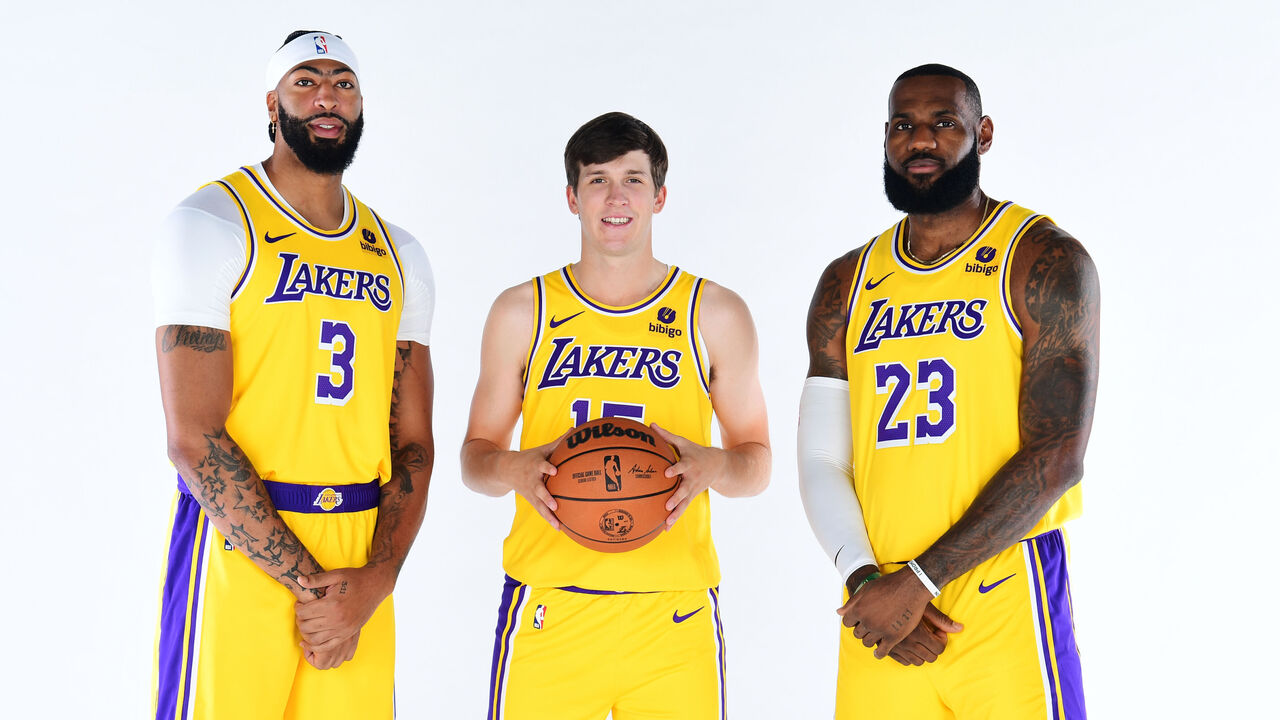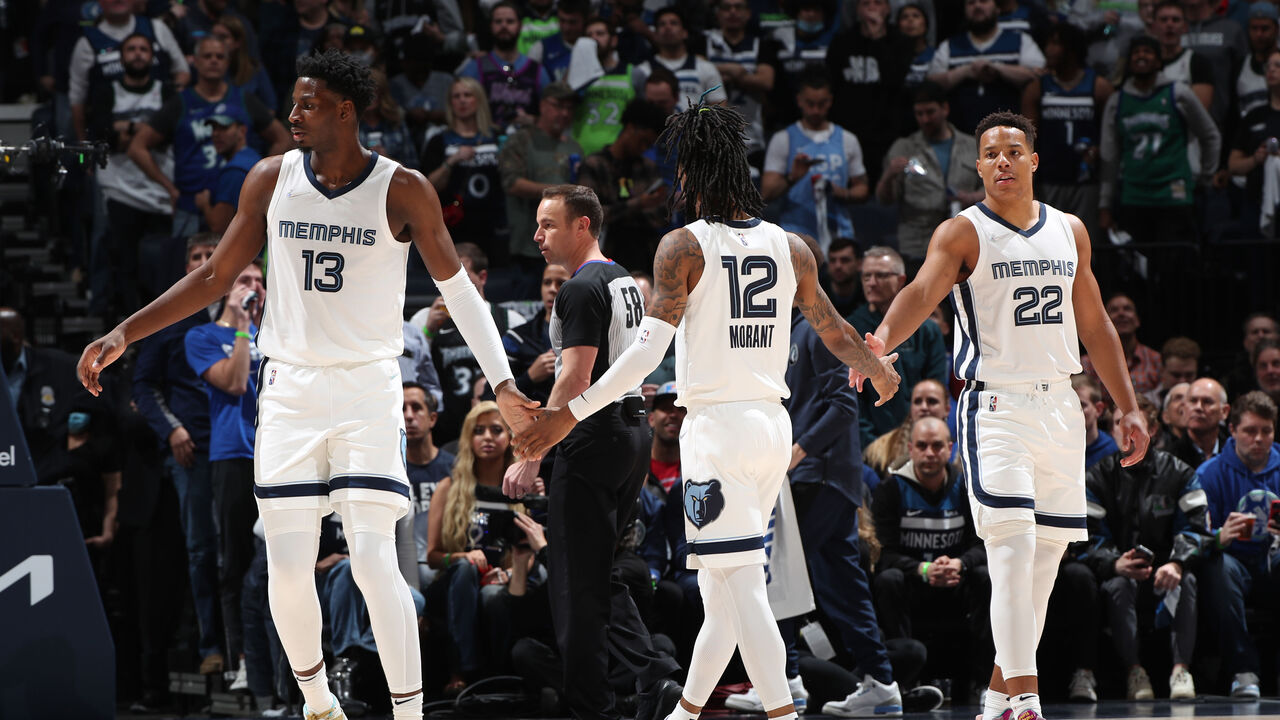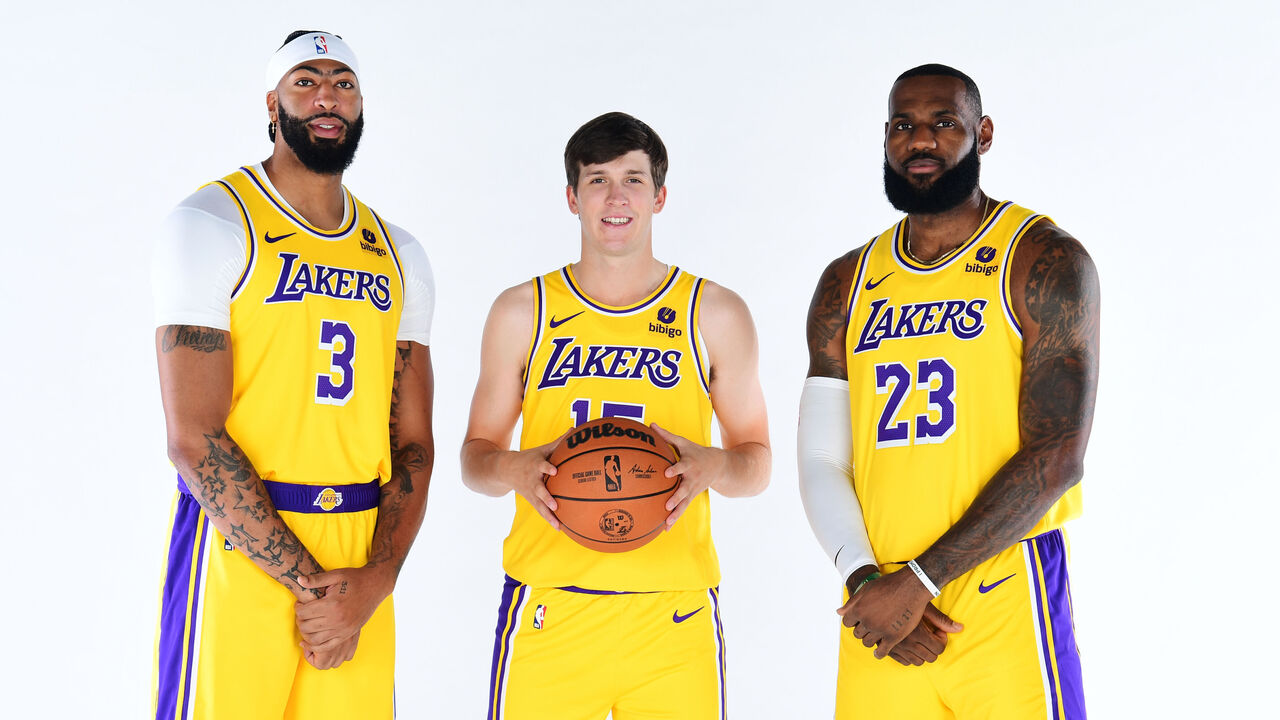Title Tiers, Part 3: Cases for and against the West's fringe contenders
Dynasties often rule the NBA, but we’re in an era of parity that’s produced five different champions and eight different finalists over the last five years. This coming season features another deep and diverse field of contenders. We’re laying out reasons to believe in them and reasons to doubt them.
Part 1 featured four inner-circle contenders. Part 2 examined the East’s fringe contenders. Last up, the second-tier contenders in the West.
Los Angeles Lakers

Reasons to believe: The post-deadline version of last season’s Lakers went a West-best 18-8 despite LeBron James missing 15 of those 26 games. They also owned the league’s second-best defense during that time and advanced all the way to the conference finals. Los Angeles now brings back six of the team’s top-seven players from its playoff rotation, with Gabe Vincent replacing Dennis Schroder.
It’s reasonable to believe the Lakers can take the next step toward championship No. 18. They have training camp and an entire season to gel this time around, Darvin Ham is entering his second season as an NBA head coach following an impressive debut, and Austin Reaves is a budding star.
Reaves’ development is especially a swing factor here. The 25-year-old averaged 13 points on an unfathomable 68.7% true shooting percentage as a sophomore, showing off his chops as a legitimate three-level scorer. He also looked plenty comfortable with the ball in his hands throughout the Lakers’ playoff run and with Team USA at this summer’s FIBA World Cup. You may not believe it, but Reaves’ shot creation, smarts, improving playmaking, and commendable defense could give the Lakers the third star they so desperately crave alongside James and Anthony Davis.
Reasons to doubt: Although there’s more depth and a better-fitting supporting cast around the team’s Big Two than a year ago, there’s still a lot riding on James and Davis. That’s concerning given the two superstars have averaged only 52 games and 44 games per year, respectively, over the last three seasons.
The revamped version of this team that survived James’ absence last winter is good enough to remain competitive with one of its stars out of the lineup. But L.A. isn’t coming close to contending without both James and Davis healthy.
In addition, while Reaves looks like the real deal, we must remain realistic. From Reaves on down, does this look like a championship-winning supporting cast? Perhaps when James and Davis were at their absolute best, but not in 2024. – Joseph Casciaro
Memphis Grizzlies

Reasons to believe: The way last season ended has understandably left a bitter taste in people’s mouths. That taste will likely linger as Ja Morant spends the first 25 games of this season suspended. But let’s not forget that this team still has all the ingredients to win 50 or more games. Memphis pushed the eventual champs harder than anyone in the playoffs two years ago, and it finished last season with the Western Conference’s best net rating despite the turmoil.
The Grizzlies are 31-15 with Morant out of the lineup since the start of the 2021-22 campaign, so they should be able to stay afloat during his extended absence at the very least. They’re a pretty safe bet to lead the league in defensive rating for that 25-game stretch, if not for the entire campaign. They ranked third last season with Morant, their weakest overall defender, suiting up for 61 games. In Marcus Smart and Jaren Jackson Jr., Memphis now has the last two Defensive Player of the Year winners manning the point of attack and the back line, respectively.
Offense will be tough to come by without Morant. However, Desmond Bane has made major strides as a creator on top of his already ridiculous shooting. He should be plenty capable of taking on more responsibility. To wit: In 1,023 minutes on the court without Morant last season, Bane averaged 25.5 points and 5.7 assists per 75 possessions with a 61.8% true-shooting mark and a plus-4.9 net rating. Jackson, too, looks ready to do more as a self-creator.
Smart, for his part, will replace Dillon Brooks’ bruising on-ball defense while offering better off-ball defense, better shooting, infinitely better playmaking, and (slightly) more discerning shot selection. He can capably man the point and shepherd the offense while Morant serves his suspension, then share a backcourt with Morant and insulate him defensively when he returns. Unlike the dearly departed Tyus Jones, Smart is strong and versatile enough defensively to play in three-guard lineups with Morant and Bane.
The Grizzlies can thrive by playing big with Jackson and Steven Adams sharing the frontcourt. They can also roll out smaller, stretchier groups with Jackson at center that tilt more toward offense while holding up just fine defensively. And they have a deep and varied cast of role players from which Taylor Jenkins can mix and match to fill out those lineups as situations dictate. Don’t let all the drama and the headlines obscure how good this team is at both ends of the court when operating at full strength.
Reasons to doubt: Let’s talk about Adams. He’s only 30, but he’s an old 30, and he’s coming off a significant knee injury that limited him to just 42 games last season. That may not seem like a big deal, but you can’t discount how important the bruising Kiwi is to this team’s identity and success. The Grizzlies were 8.1 points per 100 possessions better with him on the floor last season, in large part because their rebound rate was 56% when he was out there (a mark that would’ve led the league by a full three percentage points). It was only 48.5% when Adams was on the bench (equivalent to 27th).
Memphis’ mediocre half-court offense was salvaged by Adams’ second-chance generation, which is one reason his on-court offensive rating (118.7) was by far the best of all the team’s full-season players (shout out to midseason acquisition Luke Kennard). Adams is also by far the Grizzlies’ best screen-setter; things are tougher for their guards when he isn’t there clearing defenders out of the way.
A dip in effectiveness, or another unhealthy season for Adams, would be really damaging, especially considering that Brandon Clarke will also miss most or all of this season as he continues to recover from an Achilles tear. The frontcourt depth behind Jackson feels like it’s dangling by a thread. A lot suddenly rests on Santi Aldama’s development.
Memphis’ bench quietly went from a major strength to a major weakness last season, and losing the ever-reliable Tyus Jones won’t improve the situation. The Grizzlies are banking on a 35-year-old Derrick Rose (who was excised from the Knicks’ rotation last season) to replace Jones as a backup point guard. They’re also relying on a whole lot of young, unproven players (Ziaire Williams, Jake LaRavia, David Roddy, Kenneth Lofton Jr.) to provide depth at the forward spots.
Despite the addition of Kennard, who shot an absurd 54% on 5.7 3-point attempts per game after arriving at the deadline, Memphis still probably doesn’t have enough shooting. That flaw was quickly exposed in the playoffs.
Throw in the challenge of working Morant back into the mix midseason and rejiggering things on the fly, and the whole situation feels a bit too precarious to beget true championship contention. – Joe Wolfond
Golden State Warriors

Reasons to believe: Never underestimate the heart of a champion. That, and more importantly, this is still a pretty darn good basketball team, albeit one that looks a bit different from previous iterations.
After finishing 10th, 16th, and 20th, respectively, in offensive efficiency over the last three seasons, the addition of longtime rival Chris Paul gives the Warriors’ offense a curveball the team hasn’t had before – if head coach Steve Kerr wants to use it. The Point God’s presence means Golden State is now more equipped to feature some structured pick-and-roll sets in addition to the motion-heavy, read-and-react system Curry and Co. have mastered over the years. That could bode well for promising young rim-runner Jonathan Kuminga, who’s looked fantastic during the preseason.
Whether it’s with his own methodical style, doing it the Warriors’ way, or perhaps a blend of both, Paul’s arrival should also mean smoother sailing for Golden State when Curry sits. At 38 years old, Paul is no longer capable of being the self-creator a player like Jordan Poole is, but he’s a much better decision-maker and defender, and he’s been one of the game’s great caretakers for nearly two decades. Among the top 100 players in all-time assists, Paul’s assist-to-turnover ratio (3.95-to-1) ranks second.
When Paul shares the court with Steph Curry, he could emerge as one of the league’s most shocking catch-and-shoot threats. While never much of an off-ball punisher in the past, Paul shot a scorching 52.3% on catch-and-shoot 3-pointers last season. The catch (pardon the pun) is that he only attempted 88 such shots, canning 46 of them. If that attempt rate rises in Kerr’s system without Paul’s efficiency suffering, look out.
Regardless, Curry remains a top-10-level superstar, Draymond Green remains an all-world defensive anchor and playmaker, and a diminished version of Klay Thompson is still a game-breaking shooter. Plus, we haven’t even mentioned Andrew Wiggins, who was playing the best basketball of his career last season before being sidelined because of a personal matter.
Reasons to doubt: With as much ink has been spilled about all the ways Paul can help juice the Warriors’ attack, he’s still a 38-year-old guard who’s lost a step. That’s including the defensive end, where this team just looks too small on the perimeter. There’s also a decent chance Paul won’t acclimate to a new role in a foreign system. If all he ends up being is a security blanket when Curry rests and a cheaper contract that helped the Warriors rid themselves of Poole’s deal, this team won’t have enough to compete with squads like the Nuggets, Suns, and others in a loaded West.
Finally, we can’t ignore the fact that Curry, Green, Paul, and Thompson are all between 33 and 38 years old. Each of them has also missed an average of at least 20 games per season over the last two years. – Casciaro
Los Angeles Clippers

Reasons to believe: When Kawhi Leonard and Paul George are healthy, they’re still the NBA’s best wing duo – and one of the five best duos, period. As long as they’re here and playing at or near the peak of their powers, L.A. has a chance to contend, even if that possibility feels more remote with each passing year and each new injury.
The Clippers outscored opponents by 8.9 points per 100 possessions with both of them on the floor last campaign. In their previous two seasons together (excluding 2021-22 when Leonard sat out the whole year), they were even more dominant, at plus-13.2 and plus-17.6 in their shared minutes. Leonard started slow last year after recovering from an ACL tear, but by season’s end, he looked every bit like Peak Kawhi on both sides of the ball.
So, the Clippers have top-end talent that can go toe-to-toe with anyone. On top of that, they’re one of the league’s deepest teams. They’re absolutely loaded with shooting (they’ve finished in the top five in 3-point percentage every year since Leonard and George arrived), and they’re armed to the hilt on the wing.
L.A. did well to build out its guard and center depth late last season by adding Mason Plumlee, Bones Hyland, and a rejuvenated Russell Westbrook, the latter of whom gave the team a much-needed injection of pace. A full season of Westbrook, coupled with the addition of uber-athletic forward K.J. Martin, should help ensure that the Clippers don’t have the same issues with rim pressure that they’ve had in the past.
It also seems like a certainty that the front office will make a move at some point using at least one of the team’s tradeable first-rounders and its many veteran expiring contracts. James Harden is obviously the big one; he’d provide the elite passing element the Clippers have been so sorely lacking for so long and would give them a sky-high offensive ceiling. But even if they wind up aiming lower (think Malcolm Brogdon) in order to pay less (i.e. keep Terance Mann), shrinking the gap between Kawhi/PG and the rest of the roster would go a long way.
We may not see the best of this team in the regular season (we rarely do), but if L.A. is healthy come playoff time, the club will be a threat to beat anybody.
Reasons to doubt: Anyone who’s paid even token attention to this team over the last four years understands exactly why it can’t be trusted to fulfill its potential.
It’s nice to dream about how good the Clippers can be when both Leonard and George suit up, but they’ve appeared in the same game just 142 times (including the playoffs) since joining forces in 2019. L.A. has had exactly one postseason run in which both guys managed to emerge unscathed, and that ended in one of the most embarrassing collapses of the last decade. Can we expect that trend to reverse itself now that Leonard and George – who’ve missed a combined 198 games over the last two seasons alone – are 32 and 33, respectively?
Besides, it’s not like the Clippers looked particularly inspiring even when the two of them were healthy last season. For as evident as their sheer shot-making talent was, it was often obscured by an offensive process plagued by stagnancy, predictability, and individualism.
Their defense underperformed due in part to their enduring infatuation with soft switching, routinely gifting their opponents the matchups they wanted without putting up a fight. This team badly needs a sense of identity and a semblance of reliability, and it’s not like adding Harden – for as good an on-court fit as he looks to be on paper – would provide them that.
Given the mountain of evidence that’s piled up over the last four seasons, it’s hard to shake the feeling that this iteration of the Clippers is destined to amount to less than the sum of its parts. – Wolfond


